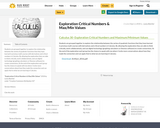
This video looks at using the product rule and the chain rule.
- Subject:
- Calculus
- Math
- Material Type:
- Lesson
- Provider:
- Khan Academy
- Author:
- Salman Khan
- Date Added:
- 01/30/2013

This video looks at using the product rule and the chain rule.

This 16-minute video lesson shows that unlike line integrals of scalar fields, line integrals over vector fields are path direction dependent.

This video looks at different ways of representing a flux integral.

This 13-minute video lesson provides a concrete example of the derivative of a vector valued function to better understand what it means.

This video provides a Visualizing derivatives exercise.

This 7-minute video lecture looks at using the Wolfram Alpha to approximate sin(x).

This 7-minute video lesson looks at visualizing the Taylor Series for e^x.

Calculus is designed for the typical two- or three-semester general calculus course, incorporating innovative features to enhance student learning. The book guides students through the core concepts of calculus and helps them understand how those concepts apply to their lives and the world around them. Due to the comprehensive nature of the material, we are offering the book in three volumes for flexibility and efficiency. Volume 1 covers functions, limits, derivatives, and integration

This 9-minute video lesson shows how to figure out the equation for the volume of a sphere.

This video looks at the Washer method when rotating around a horizontal line that is not the x-axis.

This video covers setting up the definite integral for the volume of a solid of revolution around a vertical line using the "washer" or "ring" method.

This video looks at the intuition as to why we got no net flux in the last worked example.

Desmos now has way more than just a graphing calculator (which is pretty great too!).
You can now access student or teacher accounts for free and find interactive lessons for online and classroom learning for Grade 6-12+ Math.
Topics include linear equations, 3D models, quadratic equation, exponential functions, problem solving, real world application, linear functions, etc.
Engaging activities include pizza maker, marble mini golf, scaling machines & much more!
Once you're comfortable, you can even make your own activities!

This 14-minute video lesson looks at 3 basic differential equations that can be solved by taking the antiderivatives of both sides.

Students are grouped together to explore the relationship between the vertex of quadratic functions that they have learned in previous math courses with derivatives and critical numbers in Calculus. By allowing the exploration they are able to think critically, work collaboratively, and use digital technology (graphing calculators or Desmos software) to create connections. At the end of the exploration each group has the chance to speak with me where I invite more conversations about how they made the connection and can apply that to what we are learning in Calculus.

This open-source book by Crowell, Robbin, and Angenent is a spin-off of a previous open-source book by Robbin and Angenent. It covers the first semester of a freshman calculus course.

This is a series of computer animations which demonstrate all the possible combinations of the ideal gas law or equation of state. Gases have various properties which we can observe with our senses, including the gas pressure, temperature, mass, and the volume which contains the gas. Careful, scientific observation has determined that these variables are related to one another and the values of these properties determine the state of the gas. In a scientific manner, we can fix any two of the four primary properties and study the nature of the relationship between the other two by varying one and observing the variation of the other. The variations are demonstrated using computer graphics in the animated gas lab.

This comprehensive resource from Saskatchewan Rivers Public School Division includes units of study plus curricular and assessment resources for Grade 12 Arts Education, ELA, Physical Education and Wellness, Practical and Applied Arts, Mathematics, Sciences and Social Studies. Look for rubrics, unit plans, sample year plans (and templates), Treaty Education outcomes and indicators as well lots of other teacher resources. Some of the information is not available as a login is required.

Great activities sorted by grade - you can also sort them by subject by selecting that in the top left corner!
For Grades 3-12 & ungraduate.

KiteModeler was developed in an effort to foster hands-on, inquiry-based learning in science and math. KiteModeler is a simulator that models the design, trimming, and flight of a kite. The program works in three modes: Design Mode, Trim Mode, or Flight Mode. In the Design Mode (shown below), you pick from five basic types of kite designs. You can then change design variables including the length and width of various sections of the kite. You can also select different materials for each component. When you have a design that you like, you switch to the Trim Mode where you set the length of the bridle string and tail and the location of the knot attaching the bridle to the control line. Based on your inputs, the program computes the center of gravity and pressure, the magnitude of the aerodynamic forces and the weight, and determines the stability of your kite. With a stable kite design, you are ready for Flight Mode. In Flight Mode you set the wind speed and the length of control line. The program then computes the sag of the line caused by the weight of the string and the height and distance that your kite would fly. Using all three modes, you can investigate how a kite flies, and the factors that affect its performance.